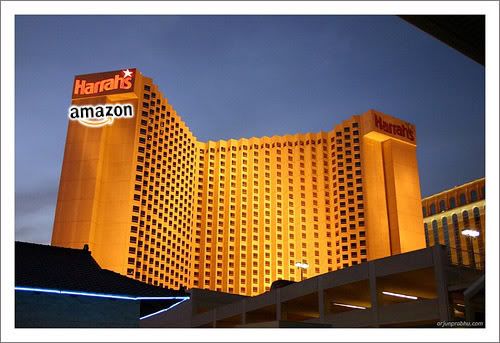Having finished “Winner Takes All: Steve Wynn, Kirk Kerorian, Gary Loveman, and the Race to Own Las Vegas”, I have arrived at a novel conclusion:
I love Amazon.com precisely because it is the Harrah’s of online shopping!

Every company - small or big, private or public - struggles with the volume of data collected, how to mine it (effectively and efficiently), and what to present in digestable form. I’ve heard the following response in countless conversations over the last year: “We have that data, it’s just not available.” And if you think you’re overwhelmed with the myriad of metrics collected online (sessions, IPs, pathing, unqiues, A/B testing, etc), consider being in Frito Lays shoes… they’d die for the sorts of information most .com’s can collect.
But that’s where Amazon set’s itself apart. Your shopping experience is finely customized to your habits and usage. They understand the value of every pixel on the page and the impact of moving a particular module. As a buyer, you get the sense that every piece of real estate is completely calculated… and those calculations are precise enough that I read the customer reviews, encourage related items, and open every Amazon.com delivered email. They also know enough about me to realize that I’m a heavy shopper – so when they launched the “Amazon Prime” service, they provided me a free account - well aware that it would encourage me to purchase more frequently and in more diverse categories (I buy all of our toiletries, household items and nonperishable groceries on Amazon…).
So when I read about how Harrahs algorithmically incents it’s loyalists and markets to its database of 16 million gamblers, I realized how similar their offline practices are to the online world… it just so happens that Harrah’s is best-in-class offline and Amazon is online.
Ecommerce and consumer-facing websites sit on a gold-mine of data that: 1. Is immensely valuable 2. Is never fully utilized (sometimes scarily underutilized) 3. Is highly unique (both to vertical and industry)
From Winner Takes All (on Amazon here):
The sixteen million gamblers in Harrah’s database were grouped according to characteristics such as zip code, how long they’d been a Harrah’s customer, how much money they were likely to lose, how frequently they gambled, and the types of games they played. Harrah’s tested hypotheses against control groups in a series of “conjoint analyses.” That’s just an academic term for measuring which bundles of goodies people prefer…
The propeller head’s technique was Pavlovian. Unbeknownst to the gamblers, Harrah’s statistical model set calendars and budgets that predicted when they would gamble and how much. It calculated how much each gambler was likely to lose to Harrah’s over his or her lifetime: their “predicted lifetime value” to Harrah’s.
Harrah’s computers spit out behavior modification reports so personalized that they could suggest that one gambler would respond to a cash offer while another would be more motivated by a free hotel room.
A lady who showed up every two weeks would be labeled “past due” if she didn’t sup up for a month, but a guy who showed up twice a year wouldn’t be past due for fourteen months. - Pages 173-175
Loveman was enthusiastic about applying technology in every way possible. In a 2005 pilot program, Harrah’s put radio-frequency tracking tags on cocktail waistresses at the Rio to study how long it took them to serve their customers.
Taking a cue from banks and airlines, Harrah’s launched tiered frequent-gaming cards with gold, platinum, diamond and, eventually, Seven Stars thresholds. Like carrots on a sticks, the rewards escalated as customers gambled more with Harrah’s. Diamond echelon players were expected to lose at least $5,000 a year. Seven Stars players were expected lose $50,000.…
Harrah’s began tracking gamblers’ losing streaks in real time – while they were still sitting at the slot machine. As soon as a gambler stuck their Total Rewards frequent gambler card in the machine, the computer started comparing their actual losses and winnings against the predicted odds. Big losers were flagged in the system. A “luck ambassador” was then dispatched to perk them up with friendliness and a token gift.…
[The] new systems were effective. Sales growth at it’s existing casinos went from 9.1% in the fourth quarter of 1998 to 11.4% the following quarter and to 14.6% the quarter after that. - pages 176-177

